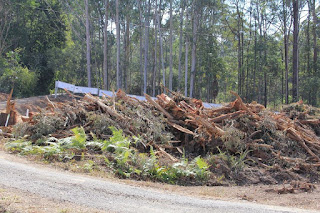 |
| Rainforest bulldozed along Sippy Creek, Sunshine Coast - Pic Ted Fensom |
The clearing of
rainforest and other native vegetation on the Sunshine Coast is
accelerating as the Queensland Government pushes ahead with a massive
$1 billion program to expand and upgrade the Bruce Highway. At the
same time, landholders on the coast are making the most of the
absence of meaningful state land-clearing laws, with the rampant
destruction of native forest being documented on at least nine properties.
What is happening on
the Sunshine Coast is indicative of what is happening across the
state as the recently re-elected Labor government stalls on its
pledge to restrict land-clearing.
 |
| Forest converted to mulch piles, Steve Irwin Way, Sunshine Coas - Pic Ted Fensom |
Of particular
concern on the Sunshine Coast is the fact that the government has
sliced into the Palmview Conservation Park, Mooloolah River National
Park, Beerwah State Forest and other reserves to make way for its
roadworks. National parks are supposed to be sacrosanct and there is
little point in protecting land as reserves if they can be carved up
at the stroke of a pen.
Environmentalist
activist Ted Fensom has documented the extent and nature of the
clearing across a large swathe of the southern Sunshine Coast. He
says critical habitat for koalas and numerous plant and animal
species have been devastated without meaningful environmental
assessment studies being conducted, and with little consideration for
far-reaching ecological consequences and the loss of biodiversity.
 |
| Old growth trees felled at Palmwoods, Sunshine Coast - Pic Ted Fensom |
According to Fensom,
the highway works are particularly devastating. “The area affected
by the huge clearing for works associated with the Bruce Highway is
beyond comprehension and stretches many kilometres north to south,”
he says. “Koala habitat and precious rainforest has been turned
into giant mulch piles. These pockets of biodiversity are
disappearing every week around the Sunshine Coast.”
According to the
federal Department of Environment and Energy, the roadworks are affecting populations of koala, listed as a threatened species under the
Environment Protection and Biodiversity Conservation Act, as well as
subtropical lowland rainforest, listed as a threatened ecological
community. However, the department approved the development with
conditions.
 |
| Rainforest logging and clearing at Sippy Creek, Sunshine Coast. Circled sign says: "Environmental Protection Zone" |
Fenson says the rate
of tree-clearing elsewhere around the Sunshine Coast is “going
beserk”. Native vegetation has recently been - or is in the process
of being - bulldozed or logged at four sites around Palmwoods; two
properties near Woombye; and two areas around Caloundra, including a
koala habitat corridor at Little Mountain; and a 60-hectare holding in Yandina. Areas where further
clearing is planned include Tanawah North, Coolum West, Nambour
Heights, Buderim, Bli Bli, Mooloolah and Beerwah East.
 |
| Activist Ted Fensom |
The state Liberal
National Party Government in
2012 gutted the Beattie Labor Government's 2004 laws controlling
land-clearing. In 2016, the minority Palaszczuk Labor Government
failed
in its bid to again tighten up land-clearing laws when
crossbenchers joined the LNP – ever the slave to the old school
Bjelke-Petersen Nationals - to defeat the move. An estimated 300,000
hectares of Queensland bushland are being bulldozed annually as a
consequence.
 |
| Clearing for a Bruce Highway on ramp, Sippy Downs, Sunshine Coast |
Labor was returned
to government in the November 2017 election, this time with a
majority.
Premier Annastacia
Palaszczuk pledged to reintroduce the tree-clearing restrictions but
no time-frame was set, and the state's new Environment Minister,
Leeanne Enoch, has had little to say about the matter. Her office
declined to respond to requests for comment. The Queensland Department of Main Roads and Transport also declined to comment.
 |
| Land-clearing at Woombye, Sunshine Coast - Pic Ted Fensom |
It is a matter of
considerable regret that the Greens and some in the environmental
movement pay little attention to the land-clearing scandal. Their
focus in Queensland has for some time centred on the proposed Adani
coal mine at the expense of just about everything else. One leading
figure in the birding community dismissed concerns about land-clearing as
“spin” designed to divert attention from Adani.
 |
| On Twitter: Paul Sullivan is BirdLife Australia CEO |
Adani is a very
important issue, to be sure, but it is a proposal and one that may
well not fly as its proponents struggle to secure finance.
Uncontrolled land-clearing is happening right now. Ted Fensom's
photographs on this post, all taken recently across the southern
Sunshine Coast, speak for themselves. They reflect what is happening
across Queensland.
 |
| Forest destruction at Tanawah, Sunshine Coast - Pic Ted Fensom |
 |
| Bulldozer at work at Palmwoods, Sunshine Coast - Pic Ted Fensom |























